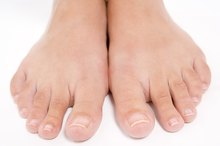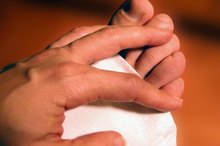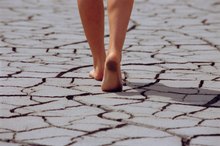How Can I Improve Poor Leg Circulation?
Your legs consist of a number of veins that can become thickened and hardened over time, according to ePodiatry.com. When this occurs, you may experience poor leg circulation, which causes pain and cramping in the legs. Poor circulation can be a serious condition because plaque that builds up in the veins can break off and cause a blood clot. Working to improve your leg circulation can improve your symptoms and prevent a potentially deadly condition.
Get a Diagnosis
Poor leg circulation can be caused by a number of conditions, including diabetes, high cholesterol, high blood pressure and/or lack of physical activity, according to ePodiatry.com. Before you can begin to improve your poor leg circulation, it is important to determine what is contributing to your poor circulation. Your doctor can perform a variety of tests, such as a blood test, stress test or imaging scan to determine the cause and extent of your artery blockage, according to the University of Maryland Medical Center. Once your doctor makes a diagnosis, he may prescribe certain treatments designed to improve the underlying condition.
- Poor leg circulation can be caused by a number of conditions, including diabetes, high cholesterol, high blood pressure and/or lack of physical activity, according to ePodiatry.com.
- Your doctor can perform a variety of tests, such as a blood test, stress test or imaging scan to determine the cause and extent of your artery blockage, according to the University of Maryland Medical Center.
Lifestyle Changes
How to Increase Circulation in Feet
Learn More
Achieving a healthy lifestyle can help you to reduce your leg swelling by reducing plaque buildup in your arteries, according to the University of Maryland Medical Center. If you smoke, stop smoking. If your physician has determined you are overweight, take steps to achieve a normal weight, including eating a healthy diet and exercising regularly. If you have been diagnosed with high blood pressure, restrict your sodium intake. Take steps to reduce stress by meditating, reading or performing some other activity you enjoy. If you have been diagnosed with diabetes or another condition that can cause blood vessel damage, have a professional examine your feet for cuts or wounds, and trim your toenails to prevent injury.
- Achieving a healthy lifestyle can help you to reduce your leg swelling by reducing plaque buildup in your arteries, according to the University of Maryland Medical Center.
- If you have been diagnosed with diabetes or another condition that can cause blood vessel damage, have a professional examine your feet for cuts or wounds, and trim your toenails to prevent injury.
Treatments
Compression stockings or hose are designed to improve circulation in the body, according to Foot Smart. Wearing these on a daily basis can help to squeeze the leg muscles, thus pushing the blood back toward the heart and improving circulation. Take frequent walking breaks to get your blood flowing if you have been seated for some time. Consider using a bed or leg wedge to elevate the feet and bring blood back to your heart when you sleep. Be sure to cover your feet with blankets to keep them warm at night — keeping your extremities warm can help to improve circulation.
- Compression stockings or hose are designed to improve circulation in the body, according to Foot Smart.
- Consider using a bed or leg wedge to elevate the feet and bring blood back to your heart when you sleep.
Related Articles
References
Writer Bio
Rachel Nall began writing in 2003. She is a former managing editor for custom health publications, including physician journals. She has written for The Associated Press and "Jezebel," "Charleston," "Chatter" and "Reach" magazines. Nall is currently pursuing her Bachelor of Science in Nursing at the University of Tennessee.









